I’m staying in South India now, but planning a trip around all of India. As Americans, we don’t have much of an opportunity to see tigers, elephants, or leopards, so I think it’d be super cool to do a jungle safari, but I wasn’t sure if that was possible…?
There are many jungles in India and it’s a great place to take a safari. You could see leopards, tigers, elephants, sloths, monkeys, hundreds of species of birds, and more. Some popular jungle destinations are National Parks like Pench, Nagarhole, Ranthambore, Jim Corbett, Sundarban, and more.
I would love to find the best spot to see elephants with my family or solo. It would be really cool to see tigers and leopards, although they can be very elusive, so I did some research on what national parks have jungles and wildlife.
There are a LOT of national parks and sanctuaries in India, so I just included those which were the most highly recommended. I mostly wanted to see what types of animals we could see and where were the best places to see them. Lions, tigers, and elephants anyone? 😎
What Are the Most Popular Jungles to Visit in India?

You have a large selection to chose from, depending on whether you’re looking for animals or plants. Also, the location of the park is important, since they can be off-the-beaten-path and you may want to include this with other urban destinations on your itinerary.
Below you’ll find a lot of details to help you plan though.
Pench National Park
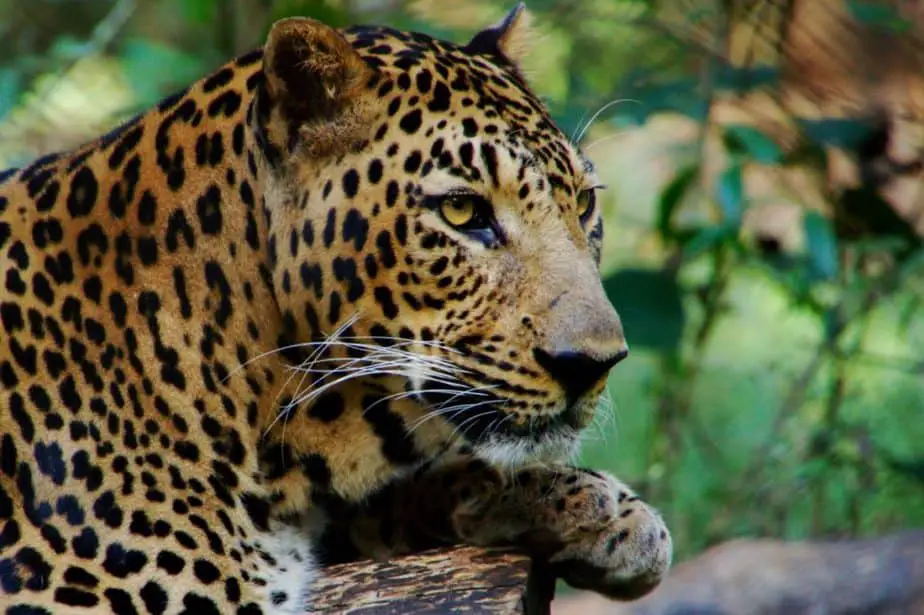
What’s Cool about Pench National Park?
Pench National Park is near Seoni in central India, where Rudyard Kipling’s iconic book, The Jungle Book was set. Maybe you’ll see Mowgli and Baloo chilling there? 🤓
Pench National Park or Pench Tiger Reserve is a dry deciduous forest with some rolling plains. It is over 758 square kilometers. There are Mahua, Palash, Teak, and Neem trees. There are also about 80 to 100 leopards and 25 to 53 tigers in Pench.
Where Is Pench?
Pench is just under 60 miles from the Sonegaon airport in Nagpur. There is a train station in Seoni that is less than 20 miles away. You can hire a driver from there and make the trek.
Things To See
- 80 to 100 leopards
- 25 to 53 tigers
- 39 mammal species
- 13 reptile species
- 285 bird species like the grey-headed fish eagle
- Jungle cats
- Sloth bear
- Langoor (monkey)
- Spotted Bison
- Sambar (deer)
- Chital (deer)
- Wild dogs
- Wild pigs
- Nilgai (blue bull)
- Kohka Lake
- Pench National Park Museum
- Totladoh Dam
When is the Best Time to Visit?
March through May is the best time to see tigers, but the temperatures can climb as high as 110°F. November through February have the best temperatures for visiting.
January to April is the best time to see birds. June is when the rains start so that’s when you can see the jungle really growing and lush.
Nagarhole National Park
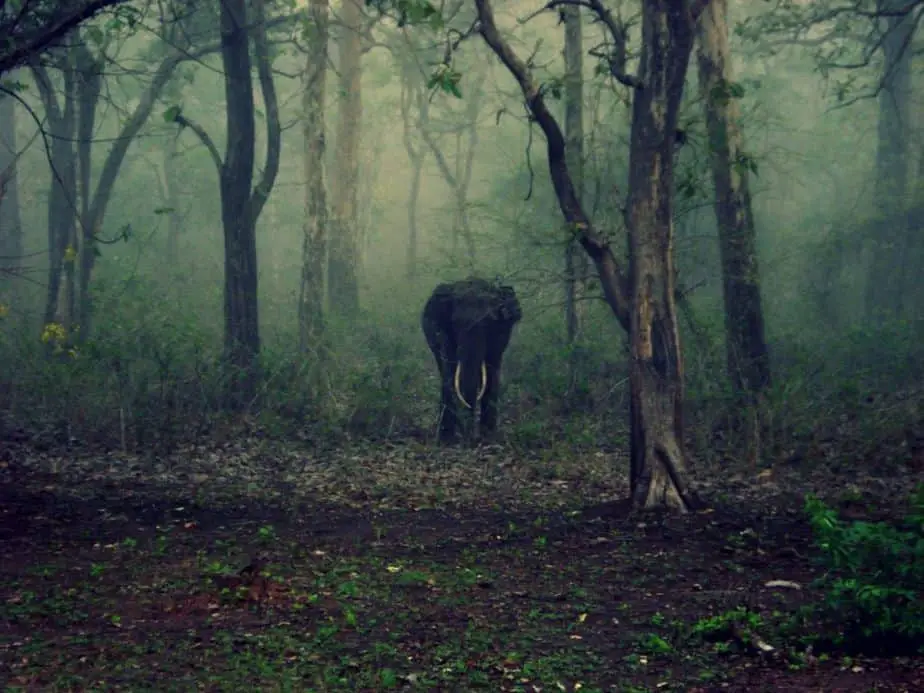
What’s Cool about Nagarhole?
Nagarhole National Park is also called Rajiv Gandhi National Park and is 247 square miles and one of the most popular parks in India. It is found in the Western Ghats and used to be the hunting reserve for the kings in the Wodeyar Dynasty in the 1400s.
Nagarhole is a great place to see elephants. There are ~6500 elephants in Southern India and many of them are in this park. There are about 1.5 elephants for every square kilometer in Nagarhole.
Nagarhole is in the state of Karnataka, which has more tigers than any state in India. The population in 2014 was 2,226 tigers.
In Nagarhole, there are 9 tigers for every 100 square kilometers of natural land, according to this article.
Where Is Nagarhole?
Nagarhole is a 4-to-5-hour drive from Bangalore or a 2.5-hour drive from Mysore in Karnataka. You can fly into the Bangalore International Airport and rent a car. You could take a train to Mysore and then rent a taxi from there.
Things To See
You can go on a safari in Nagarhole and see plenty of flora and fauna:
- Asian elephants
- Bengal tigers
- Indian leopards
- Sloth bear
- Striped hyena
- Antelope
- Ussuri dhole (wild dog)
- Jungle bison
- Grey mongoose
- Barking deer
- Sambar deer
- 250 species of birds
- Rosewood trees
- Teak trees
- Sandalwood trees
- Silver Oak trees
- Crocodile bark
- Crepe Myrtle
When is the Best Time to Visit
The best time to see wildlife in Nagarhole is April to May. The waterholes will dry up and the animals will come out to the lake. It’s kind of like in the Jungle Book when the animals have a “water truce.”
Unlike many places in India, April and May are NOT blazingly hot. The average temperature is in the mid-70s °F (mid-20s °C).
November through February has great weather to visit the park as well.
Bandipur National Park, Karnataka

What’s Cool about Bandipur National Park?
Bandipur is a National Park near Nagarhole with tigers as well. It was set up in 1974 and has ~875 square kilometers. It’s right in the middle of the Western Ghats Mountains and the Nugu River flows through the park.
There are about 382 tigers in Bandipur Park and the surrounding area including Nagarhole.
There are about 1.1 elephants for every square kilometer in Bandipur… just less than Nagarhole.
Where Is Bandipur?
Bangalore is just over 250 kilometers away from Bandipur and many people take a taxi or bus for just under 3,000 RS to 4,000 RS depending on what type of car you get.
Coimbatore Airport is over 80 kilometers away. It’s not an international airport but you can get flights from other parts of India.
There’s a train station in Mysore that around 80 kilometers away.
Things To See
- Tigers
- Elephants
- Leopard
- Wild bulls
- Gaur (bison)
- Chital (deer)
- Sloth
- Antelope
- Hyena
- Barking Deer
- Grey langurs
- King Cobra
- Python
- Adder Viper
- Marsh Crocodile
- Ospreys
- Serpent Eagles
- The area is famous for sandalwood
- Teak trees
- Rosewood
When is the Best Time to Visit?
March through May is the best time to see wildlife. October through March has the most visitors.
Murlen National Park
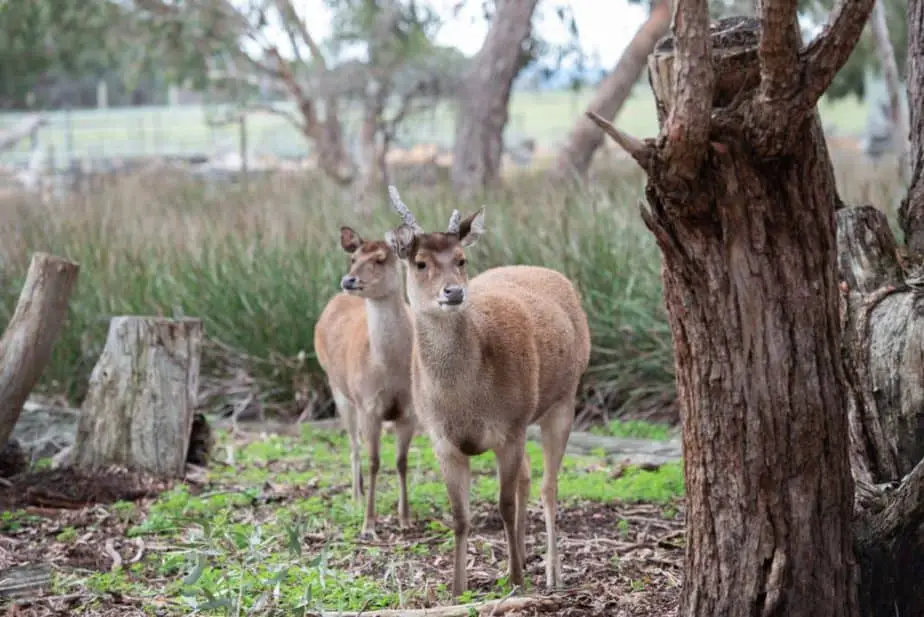
In the far east of India in the state of Mizoram, you’ll find Murlen National Park which is about 200 square kilometers.
What’s Interesting about Murlen?
Murlen National Park is known to have several bird species with reduced numbers like:
- The Dark-rumped swift
- Hume’s pheasant
- Hill Myna
Where Is Murlen National Park?
The nearest airport is the Lengpui Airport in Aizawl which is about 233 kilometers away.
You can also take a train to Silchar station which is just under 396 kilometers away.
You can then take a bus 24 hours a day to the park, or take a taxi from Aizawl.
Things To See
- Tiger
- Leopard
- Sambar deer
- Barking deer
- Malayan giant squirrels
- Himalayan black bear
- Gibbon
- Rhesus macaque
- Hume’s pheasant
- Grey partridge
- Dark-rumped swift
- 15 species of mammals
- There are 150 species of birds.
- 35 medicinal plant species.
- 4 orchid species
- 2 bamboo species
When is the Best Time to Visit
The best time to visit Murlen National Park is November to January.
Ranthambore National Park
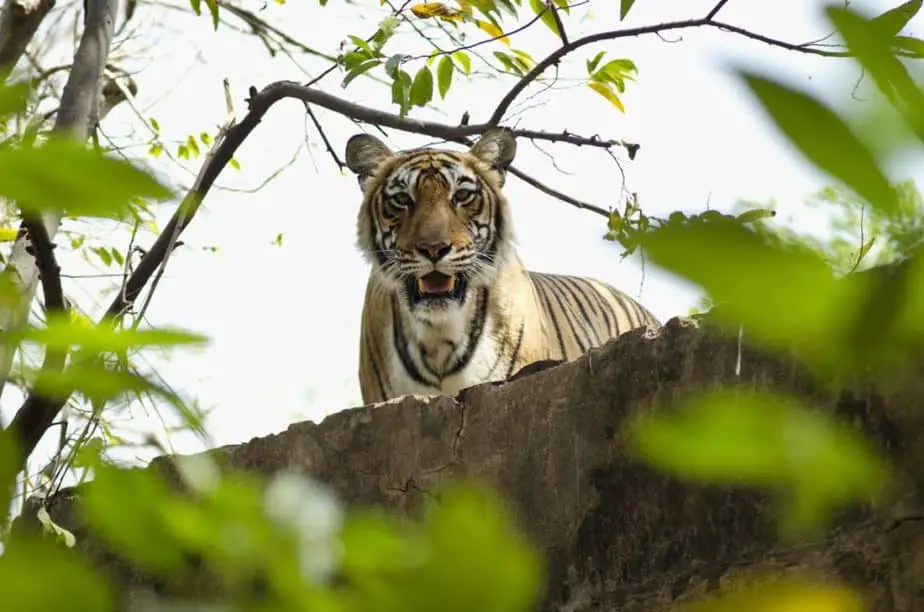
What’s Cool about Ranthambore?
Ranthambore National Park has just over 240 square kilometers of area. It was once the hunting forests for the royalty in Jaipur, but a sanctuary for the tigers was created in 1973.
According to the 2014 census, there are 62 tigers in the park. This is up from 25 in 2005.
If you want to see tigers plan to go on 3 to 4 safaris, and even then it is not guaranteed.
Where Is Ranthambore National Park?
The closest airport is in Jaipur.
You can also take a train from major cities like Delhi, Mumbai, and Jaipur to the Sawai Madhopur Railway Station. This is just 10 kilometers from the park.
Things To See
- Leopard
- 62 tigers
- Jungle cats
- Caracal
- Sambar deer
- Chital (spotted deer)
- Nilgai (blue bull)
- Chinkara (gazelle)
- Wild board
- Sloth bear
- Jackal
- Hyena
- Indian Palm Civet
- Grey Mongoose
- Porcupine
- Flying fox
- Marsh Crocodile
- Pythons
- Cobras
- 320 species of birds
- 40 mammal species
- 35 reptile species
- There are no elephants
The park is named after the Ranthambore Fort, which is a MUST to see. You can hike 5 km to get to the fort and there is enough to see that you could spend the entire day there. The views from the top overlooking the park are amazing.
TIP: If you really want to see a tiger, Ranthambore is one of the best places. There is a place called the Tiger’s Den, which is a popular place to stay in the park.
When is the Best Time to Visit?
April to June is the summer months and the best time to see tigers in the park. October through April are some of the most popular months to visit the park.
The park closes during monsoon season from July to September.
Jim Corbett National Park
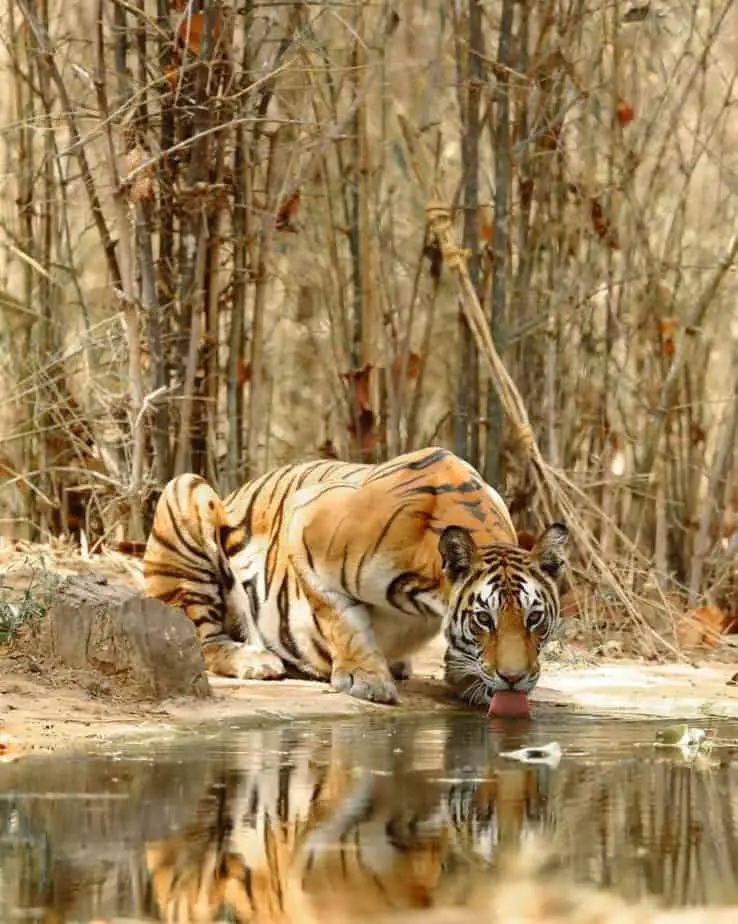
James Edward “Jim” Corbett was a famed tiger hunter, who helped create a national reserve for the Bengal tiger.
This park was originally called Hailey National Park and was changed to his name after he passed away.
The area was originally a tiger hunting ground and has a sub-tropical Himalayan climate.
What’s Cool About Jim Corbett National Park?
Thick forests cover 73% of the 520 square kilometer park.
There are five different zones to explore in the park:
- Durga Devi: Popular with bird watchers
- Dhikala Safari
- Bijrani Safari
- Dhela Safari
- Jhirna Safari
Where Is Jim Corbett National Park?
Jim Corbett National Park is northeast of New Delhi about 260 kilometers.
You can take a train from New Delhi to the city of Ramnagar. Ramnagar is just 15 kilometers from the park.
You can also take a taxi from New Delhi. It takes ~5 hours and the price is about 9-10 rs per km. It’s about 260 km, so ~2600 rs for a regular car. It would be 12 rs per km for a larger vehicle.
Things To See
- 215 Bengal tigers [the most of any park!]
- 700 Elephants
- Leopards
- Sloth bears
- Otters
- Asiatic black bears
- Langurs
- Himalayan Goral (goat-like animal)
- Rhesus Macaque
- Wild boar
- Asiatic jackal
- 3 types of otters
- 50 mammal species
- 580 bird species
- 110 tree species like Sal, Haldu, Peepal, Rohini and Mango trees
You can come to do a special tour. There are:
- Birding Tours
- Photography Tours
- Photography Workshops
- Yoga and Meditation Camps
- Angling Tours
When is the Best Time to Visit?
November through February is the most popular time. All of the zones are open to explore so you can see the most animals.
May to March is the summer here and it’s a good time to visit as well. Since this is North India it does NOT get too hot. The average temperature is around 86°F (30°C).
Sundarbans National Park
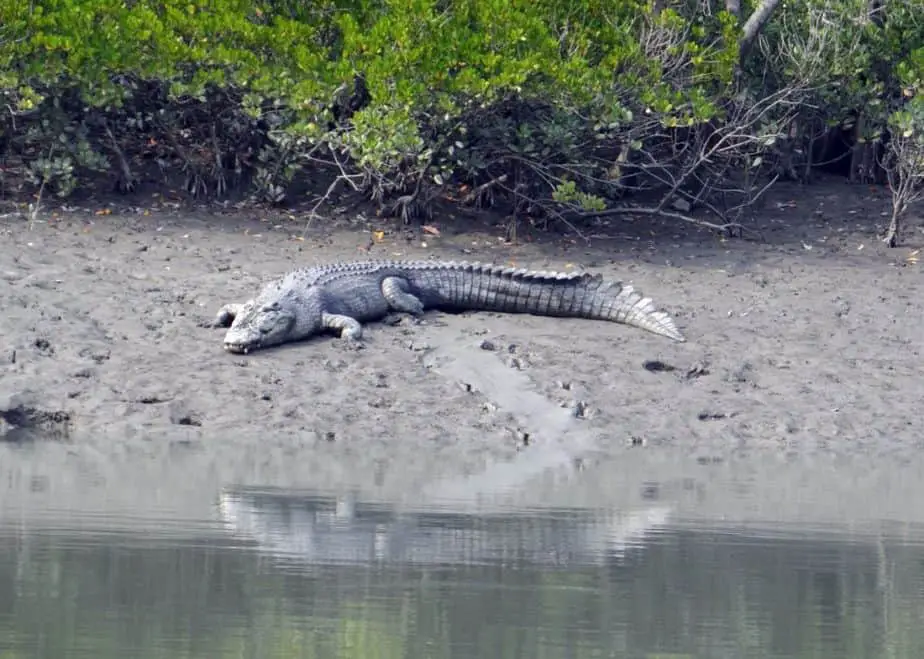
In the far east along India’s border, is another national park with a thick jungle that is a UNESCO World Heritage site.
What’s Cool About Sundarbans?
Unlike the other parks, Sundarban is the largest Mangrove forest in the world, spreading out over 38,500 square kilometers. It straddles the border between Bangladesh and India.
There are 102 islands on Indian soil. 48 are forested and 54 are inhabited. To get around, you will use ferries.
There are almost 200 Bengal Tigers in the park. The area is so huge it also has a number of inhabited areas.
Do be careful though, in this area ~50 people are killed each year by tigers.
Where Is Sundarbans?
You can fly into the Netaji Subhas Chandra Airport in Kolkata (Calcutta). The park is over 160 kilometers away.
You can take a train to the Canning Railway Station. This station is almost 50 kilometers away from the park.
There are buses or you can take a taxi here. The price is as low as 3000 rs for a regular car.
Things To See
- ~200 Bengal Tigers
- Estuarine Crocodiles
- Otters
- Wild boar
- Spotted deer
- Porcupines
- King cobra
- Python
- Water Monitor Lizard
- Turtles
- 2 species of dolphin
- 58 mammal species
- 248 bird species
- More than 300 types of plants
When is the Best Time to Visit?
If you want to see tigers, the best time is March through May. The high temperatures are 107°F (42°C) during this time, but on average it is lower. It is very hot though.
The most popular time is October through February. The winter temperatures are very nice with average temperatures around 75°F (25°C).
Bandhavgarh National Park
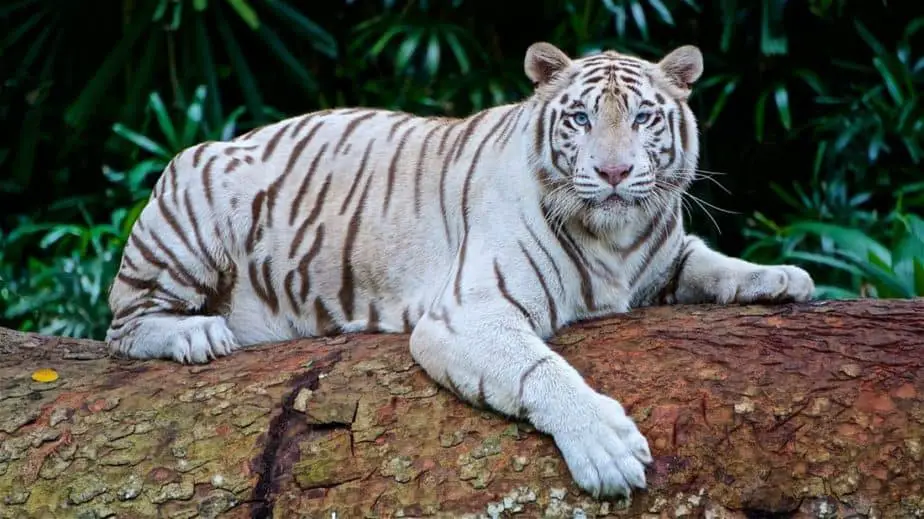
This park was mentioned in the classic epic poem, the Ramayana. Lord Rama gave the park to his younger brother Lakshmana. You can read about the history of the area in books like Narad Panch Ratna and Shiv Puran.
The park is just over 100 square kilometers and has on average 1 tiger every 5 kilometers. It’s not far from the Vindhyan Mountains in central India.
The park is named after the Bandhavgarh Fort, which is right in the heart of the park.
What’s Cool About Bandhavgarh?
Bandhavgarh is unique because white tigers were once spotted here, albeit very rarely. According to records in a nearby Rewa Palace, white tigers were spotted 8 times in 100 years.
No white tiger sightings have occurred for over 50 years.
CNN Travel says it is in this park that you will have the highest chance of spotting a tiger.
Where Is Bandhavgarh?
Bandhavgarh is southeast of Delhi about 850 kilometers.
You can fly into the airport at Khajuraho. Then you are about 270 kilometers away or 6 hours.
You could take a train to Umaria Railway station. Then the drive is about 35 kilometers away or 40 minutes.
Things To See
- 45 – 50 Tigers
- Leopards
- Sambar deer
- Muntjac
- Nilgai
- Wild boar
- Gaur
- Languar monkeys
- Barking deer
- Sloth bear
- Asiatic jackal
- There are more than 150 bird species
- Cuckoos
- Blue bearded Bee-eater
- Asian Koel
- White-rumped Needletail
- Sirkeer Malkoha
- Rose-ringed Parakeet
- Green Bee-eater
- White-rumped Spinetail
- Collared Scops owl
- Usually there are are no wild elephants in Bandhavgarh National Park
You can also view the Bandhavgarh Fort. It’s an hour hike and you’ll need a guide. But the views at over 800 meters above sea level are well worth it. The fort is over 2000 years old and there’s a 35-foot statue of Lord Vishnu (the protector of the universe).
TIP: If you really want to see a tiger, there are ‘tiger shows.’ A tracker will spot the tiger, relay the information to the guide and you will be brought in. Bring your camera!
When is the Best Time to Visit?
The best time to see tigers is January, February, and March. The best time to see birds is from October through January. November and December are the most popular times to visit the park.
The park is only open from October to the end of June.
Kanha National Park
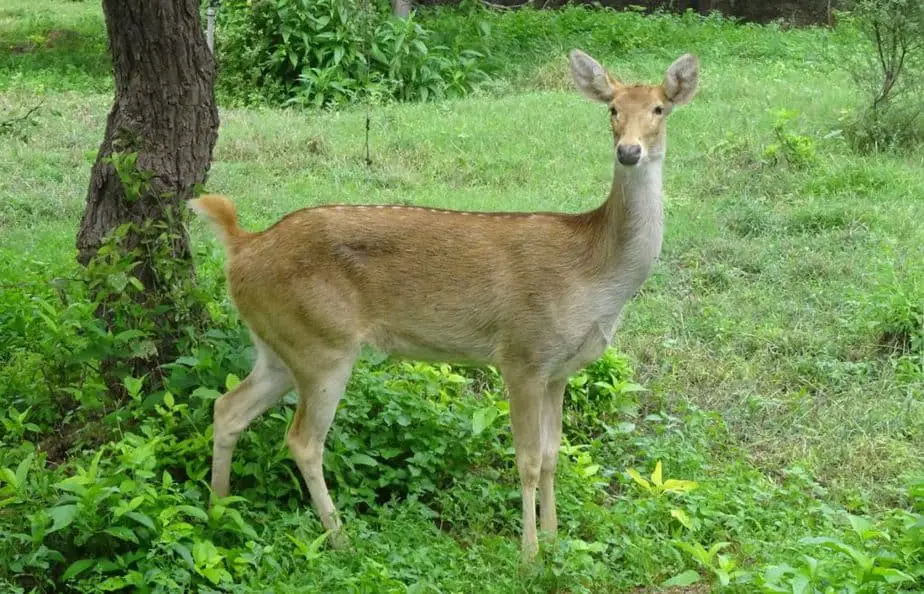
As a kid, Rudyard Kipling read stories of British travelers who adventured in Kanha and it is said that the descriptions of the jungle there inspired him to write the Jungle Book.
Kanha National Park is over 940 square kilometers with dry thorny trees to tropical deciduous forests.
What’s Cool About Kanha National Park?
There are 78 tigers (from the 2014 census) and over 8 tigers for every 100 square kilometers.
The park is also a sanctuary for the almost extinct swamp deer the Barasingha. The population had dwindled to only 66 deer in the 1970s and now due to their conservation efforts, the numbers are over 500.
Where Is Kanha?
Kanha National Park is just 150 kilometers from Pench National Park. But it’s also about 1000 kilometers southeast of Delhi.
The nearest airport is Jabalpur if you’re flying in from India. It’s about 165 kilometers away from the park.
You can take the train to Gondia Railway Station, which is about 145 kilometers away from the park.
There are regular taxis going to the park from Jabalpur. Rates for small cars are around 12 rs per km. You’re looking at around 2000 rs for the trip, more for larger cars.
Things To See
- ~78 Tigers
- Indian Gaur (wild bison)
- Chital (deer)
- Langurs
- Indian wild dog
- Swamp deer
- Sloth bear (it’s like Baloo’s character in the Jungle Book)
- Mongoose
- Indian wolf
- Hyena
- Jackal
- Jungle cat
- Sambar deer
- Indian tree shrew
- Porcupine
- There are over 70 tree species
- There are over 300 bird species
- There are over 800 flowering plant species
- There are no leopards here though.
When is the Best Time to Visit?
March is best for seeing tigers without getting too scorched by the sun. April and May are good as well but hotter.
November through February is the best time to visit the park. The summers are very hot here. This is the best time for bird watching. Many birds migrate here during the winter months.
The park is closed from July to early October.
Gir National Park
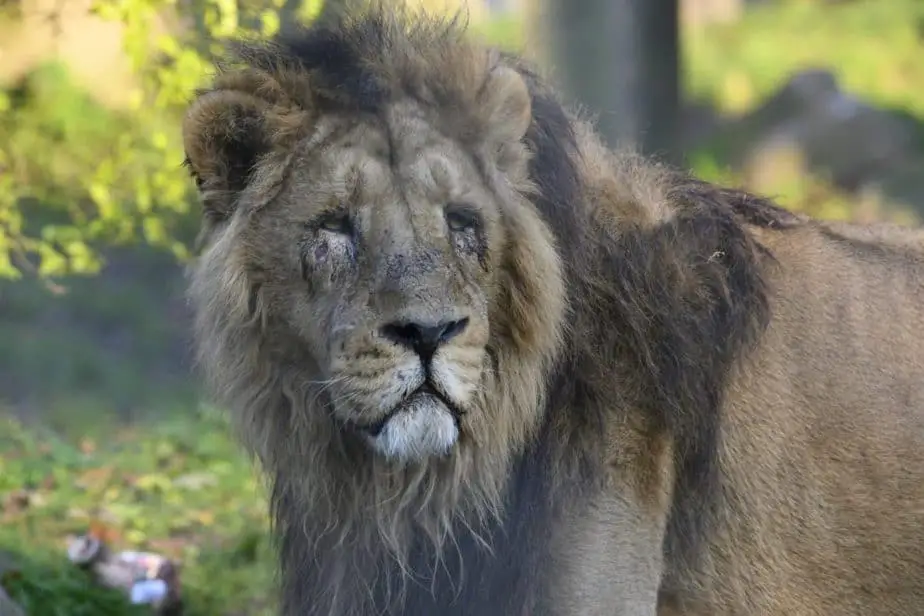
Gir National Park is on the west side of North India. The total area is over 540 square miles, with over 100 square miles of protected park area, consisting mainly of dense deciduous forests.
What’s Interesting About Gir National Park?
There are 523 Asiatic Lions (2015 census) in the area, which were once endangered. The Forest Department says there are over 600 now. The government is preserving them with a special lion breeding program (is it appropriate to say, bowchickawowow?)
Where Is Gir?
Gir National Park is in Gujarat. The nearest major airport is in Ahmedabad, which is about 7 hours away. You could also fly into Rajkot or Dui, which are 2 to 3 hours from the park.
Junagadh Railway Station is a popular way to get to the park. You can take trains from Ahmedabad and Rajkot.
Then take a taxi for about 1.5 hours to the park. There are buses that run as well. Prices are about 2000 RS.
Things To See
- Lions
- Leopards
- Bears
- Foxes
- Hyenas
- Wild asses
- Cobras
- Mongoose
- Jackal
- Desert cat
- 38 mammal species
- 37 reptile species
- There are more than 300 species of birds
- Teak trees make up nearly half of the forest
- Acacia trees
- Bamboo
- Jamun
- Amla
- Salia
- There are no tigers here though.
When is the Best Time to Visit?
April and May are the best months to see wildlife. However, it is getting hot during these months with average temperatures around 80°F (26 °C) in April.
The most pleasant weather runs from December through March.
The park closes during the monsoon season: June to October.
Kaziranga National Park
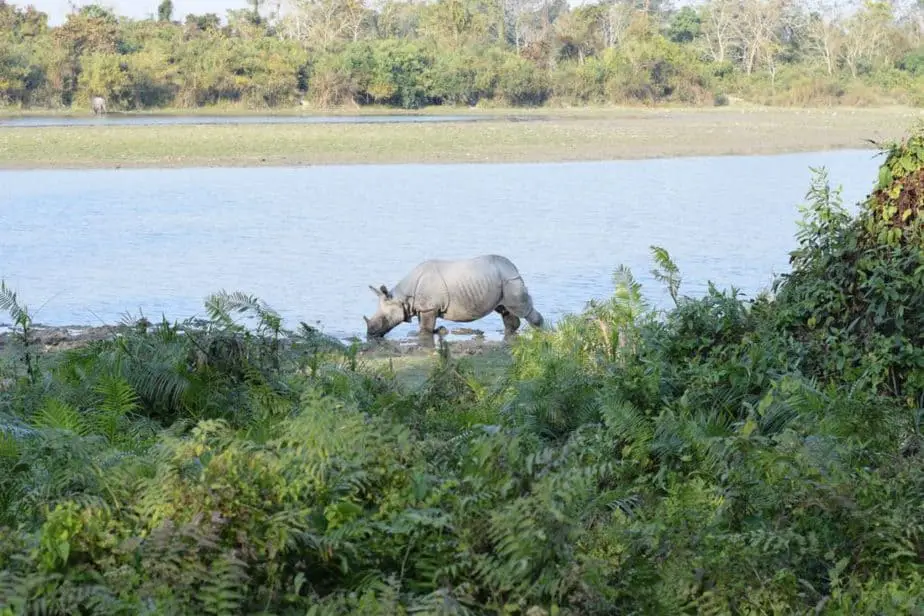
Kaziranga National Park is an older park, it was founded in 1905.
What’s Cool About Kaziranga National Park?
You can see Indian one-horned rhinoceroses here. The 2015 census counted over 2,400 rhinos, which is over two-thirds of the world’s population.
There are also 104 tigers in the park. Give or take a few 😉
Where Is Kaziranga?
The near major airport is Guwahati International, which is 217 kilometers away. Jorhat Airport is smaller but only 97 kilometers away.
Furkating Railway Station is 75 kilometers from the park.
You can then take a bus or taxi from there.
Things To See
- One-horned rhinos
- Tigers
- Elephants
- Wild water buffalo
- Swamp deer
- Leopards
- Fishing cats
- Jungle cats
- Bengal foxes
- Flying squirrels
- Wild boar
- Over 35 mammal species, including 15 which are threatened with extinction
- Over 575 bird species, including 25 which are threatened with extinction
When is the Best Time to Visit?
November through February is the best time to visit for mild temperatures. If you want to avoid the crowds, February to May is hot (between 7°C to 37°C) but the park is still accessible.
There is flooding during monsoon season during June through October.
Chinnar Wildlife Sanctuary
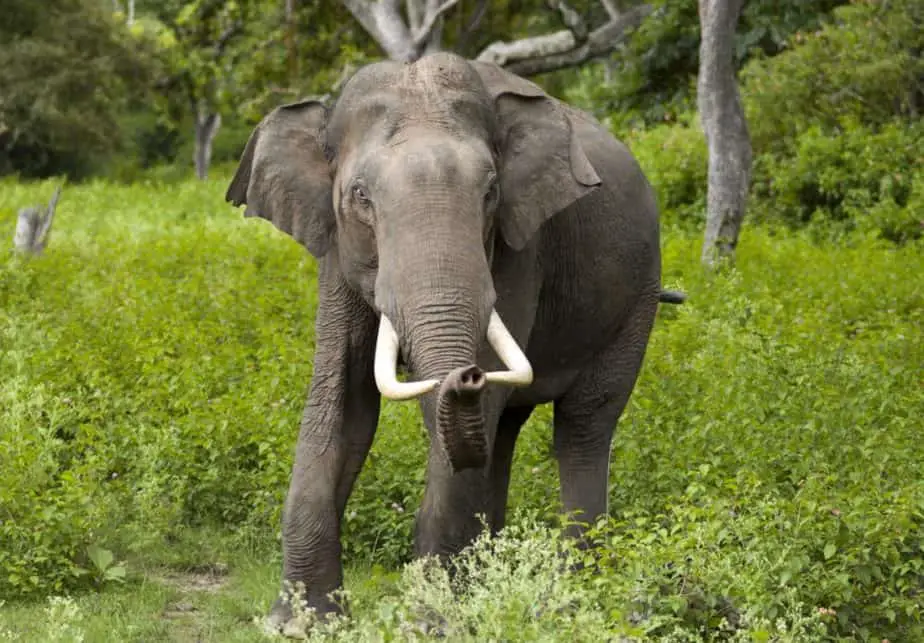
Chinnar Wildlife Sanctuary is in south India in Kerala along the eastern side of the Western Ghats. It is mostly dry deciduous forests on 90 square kilometers.
What’s Cool about Chinnar Wildlife Sanctuary?
The Great Grizzled Squirrel is protected here, as its numbers have dropped to under 200 and are one of the species closest to extinction on the planet.
You may see tigers here, but they are rarer than the other national parks. Tigers don’t live in the park.
You can see some albino bison as well.
How To Reach Chinnar
The nearest airport is Coimbatore Airport, which is 115 kilometers away. Kochi Airport is the closest major airport and it is 208 kilometers away. You could get a taxi that would take about 5.5 hours.
Aluva and Pollachi Railway Stations are about 200 and 60 kilometers respectively.
Munnar is the closest town, about 62 kilometers away.
Things To See
- The Great Grizzled Squirrel
- Wild Elephants
- Tigers
- Panthers
- Albino Gaurs (bison)
- Yellow-throated Bulbul
- Spotted deer
- Sambar deer
- Langur
- Peacocks
- Black eagles
- Porcupine
- Jackal
- Sloth bear
- Jungle Cat
- There are 28 mammal species
- There are 52 reptile species
- 963 species of flowering plants
- 225 bird species
- 14 fish species
- 156 butterfly species
- Mugger crocodiles
- Spectacled cobras
- Sandalwood forests
- Beautiful Waterfalls
The night safari is highly recommended. There is also a watchtower that will give you a bird’s eye view of the wildlife.
What is the Best Time To Visit?
December to April is the best time to visit Chinnar Wildlife Sanctuary. This is south India so the temperatures get very hot in May through August.
The monsoon season only goes from October to November though.
Related Question:
What Are the Most Popular Wildlife of India?
The most popular wildlife that tourists enjoy seeing are the Indian elephants, Bengal tigers, Asiatic lions, One-horned rhinoceroses, Indian leopards, spotted deer, Sambar deer, sloth bear, Barashinga (swamp deer), Chital (deer), Langurs, water buffalo, wild boar, king cobras, pythons and many more.

